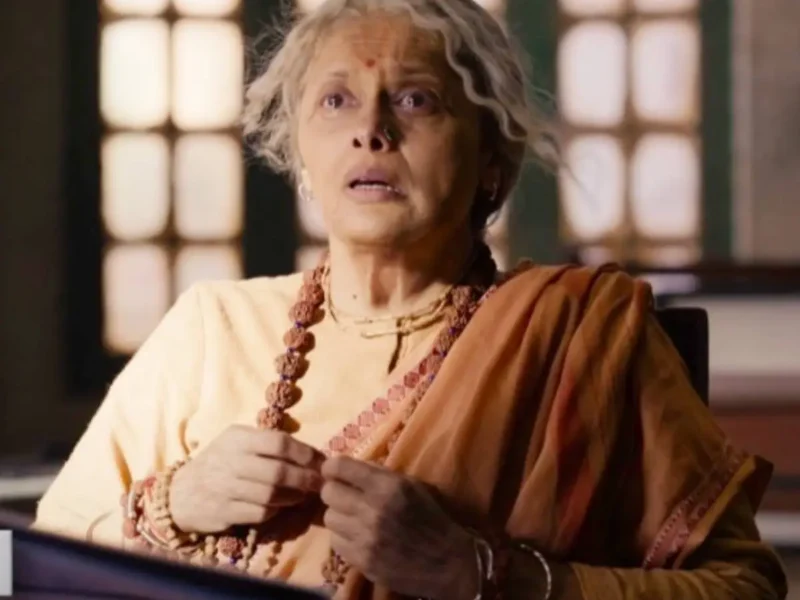From ‘Bombay Noir’ To Breezy Rom-Coms, Films That Defined Dev Anand
NEW DELHI, (IANS) – In his youth, he had gone from his home in Gurdaspur to Amritsar to get medicines for his ailing mother.
To quench his thirst, he ordered a glass of sugarcane juice from a stall near the Golden Temple. When the vendor took a closer look at him, he exclaimed that Dev Anand had the sun on his forehead, foretelling greatness.
The prediction did come true — Dev Anand did become a star that burnt bright across an over six-decade-long career.
With his undeniable charm, fast diction, the slight lopsided gait, trademark nodding to add emphasis, the winning winsome smile, and the flamboyant sartorial style, Dev Anand sparkled in a career that began before Independence and lasted into the second decade of the 21st century.
Included in the pantheon of the top three heroes of Hindi cinema in the 1950s, he not only outpaced his peers Dilip Kumar and Raj Kapoor, who did around 70-odd films each, with almost 120 to his credit, but remained a leading man well after the other two – who were about a year older and a year younger, respectively – had taken up playing fathers or roles more suited to their ages, or given up acting altogether.
Also, what marked him out from the other two was that an overwhelming majority of his roles were of characters in urban settings, unlike Dilip Kumar, who had no compunction in portraying rustic characters, and Raj Kapoor, whose specialty was the small-town simpleton.
Popularizing what became to be known as “Bombay Noir”, where he played characters with a tinge of grey or moral ambiguities, as well as the staple family dramas or breezy romantic comedies, and thrillers, and even the odd costumed swashbuckler, Dev Anand did not break new ground.
Ashok Kumar pioneered playing an anti-hero in “Kismet” (1943), and both Dilip Kumar and Raj Kapoor had done too, say in “Footpath” (1953) and “Awara” (1951), respectively, but he brought a dash of panache to his roles with his trademarks.
While he is most known for films like “Guide” (1965), with its bold themes – for the day – and crime flicks, like “Jewel Thief” (1967), with its colorful locales, glamour surplus, and unexpected twist, and “Johny Mera Naam” (1970), which incorporates the lost siblings plot, and “Hare Rama Hare Krishna” (1971), which would be a sort of swan song to the hippy culture, there was a lot more in his repertoire.
Let’s traverse through a dozen-odd, good, and bad, known or forgotten.
“Hum Ek Hain” (1946): Marking Dev Anand’s debut, this film, coming at the cusp of India’s Independence – and Partition – was prescient in its espousal of inter-faith harmony and how inimical forces could seek to destroy it. Set in a village, it chronicles a woman landowner (Durga Khote) raising up her son (Dev Anand) along with three adopted orphans, a Dalit girl (Ranjitkumari), a Muslim (Rehman), and a Christian (R.V. Rane) and how seeds of division are planted before they recombine to defeat the nefarious forces.
“Afsar” (1950): An adaption of Russian author Nikolai Gogol’s satire “The Inspector General”, the film – the first of Dev Anand’s newly set up Navketan Productions – has city resident Dev Anand reaching a village to find work but getting mistaken for a government agent by locals amid the land reforms drive.
“As he enjoys being feted and courts the zamindar’s daughter (Suraiya), a letter to his friend in the city detailing his experiences is intercepted by the zamindar’s men and read out in a village gathering. Alerted by this, he and his paramour make a rush to the railway station to escape, but do they make it? Suraiya’s “Mann mor hua matwala” is a highlight.
“Baazi” (1951)”: Scripted by Balraj Sahni (who, however, did not like the result much!), this Bombay Noir was the first hit for Dev Anand’s Navketan banner, as well the first with Kalpana Kartik – who would eventually become his wife.
“It is the story of an unemployed youth, whose penchant for gambling gets him close to a nightclub singer (Geeta Bali, who croons “Tadbir se bigdi taqdeer) and then into all sorts of trouble, including a murder charge. Does he escape with his life?
“Insaniyat” (1955): The Hindi version of a Telugu hit, this rare outing into a costumed swashbuckler has Dev Anand – with a moustache – acting together with Dilip Kumar for the first and only time. That is one saving grace of this rather formulaic potboiler, apart from Jayant’s overboard acting as a tyrannical ruler and a chimpanzee named Zippy!
“Solva Saal” (1958): One of the few Hindi movies where the action takes place in a few hours – following close on heels of Madhubala’s pathbreaking “Gateway of India” (1957), this romantic comedy has Waheeda Rehman eloping with her shifty beau, but Dev Anand, who plays a journalist, overhears them on the train and decides to play a guardian angel to her – despite her annoyance. There is a twist in the denouement. A cameo by director Raj Khosla is the highlight – as well as “Hai apna dil to awara”.
“Kala Pani” (1958): Featuring Dev Anand as a dutiful son trying to absolve his father of a murder charge, his appearance in all black in the film gave rise to the urban rumor that he was not allowed to wear the color subsequently because it had on his female fans! It stars Madhubala as the feisty journalist and Nalini Jaywant as a prostitute helping him, while Kishore Sahu, Krishan Dhawan, Sapru, Nazir Hussain, and Bir Sakhuja round up the cast.
“Hum Dono” (1961): A realistic look at what costs an armed forces career imposes on the men in uniform – and their near and dear ones – especially when war comes. Dev Anand, in his first double role, impressed both as the earnest young officer who expresses his sentiments in “Main zindagi ka saath nibhata chala” and the elder, and the louder, officer – whom several army officers watching the film claimed to have known! Sadhana and Nanda played their lady loves, with music composer Jaidev proving himself in his first chance.
“Maya” (1961): A quirky look at wealth and poverty, this film has Dev Anand, a wealthy scion, become depressed at realizing that his friend and girlfriend only are with him for his riches, and decides to see how the poor live. Mala Sinha plays his love interest (“Tasveer teri dil mein” is a melodious duet). Other highlights are a party organised by the servants of the rich while their employers are away and Jayant as a ruthless gang leader and with Amjad Khan as a henchman.
“Teen Devian” (1965): A timeless urban love story, this has suave aspiring poet Dev Anand forced into a “Judgment of Paris” – choosing a life partner from the three women he befriends – girl next door (Nanda), vivacious actress (Kalpana), and cool socialite (Simi Garewal) – while his music shop owner employee I.S. Johar plays a sort of “love guru”.
But it is no tearjerker – each of the women being open to moving on. A bouquet of melodious songs, including “Khwab ho tum.”, “Aese to na dekho”, “Likha hain teri aankhon mein”, and Calcutta of the 1960s complements the appeal.
“Duniya” (1968): A slick courtroom drama, with twists galore, but also lashings of the family melodrama and lost and found relatives and friends, this film sees young and brash lawyer Dev Anand lock horns with redoubtable public prosecutor Balraj Sahni, whose purported son (Prem Chopra) has been murdered allegedly by Dev’s childhood friend (Pakistani actor Suresh). Vyjayanthimala is the love interest, Madan Puri among other accused, and stern judge D.K. Sapru presides over the bench.
“Prem Pujari” (1970): The first directorial venture of Dev Anand, this war and espionage thriller was a flop but has become a cult subsequently aided by memorable songs (“Shokhiyon mein ghola jaye”, “Rangeela re”, “Phoolon ke rang se”), lush locales, leading ladies Waheeda Rehman and Zaheeda (Nargis’ niece), and some provoking questions about patriotism and pacifism. Don’t miss small cameos by Amrish Puri and Shatrughan Sinha – as a Pakistani army officer.
“Tere Mere Sapne” (1971): A gripping but tad grim tale about duty and redemption, this film has Dev Anand as a doctor posted to a mining site and his interactions with his cynical colleagues there (including brother Vijay ‘Goldie’ Anand, who also directed the film), eventual marriage to a local teacher (Mumtaz), and a chain of circumstances that lead him back to the city, where he encounters a film actress (Hema Malini) and strays personally and professionally. Does he regain his path?
“Manpasand” (1980): An adaptation of “My Fair Lady” in present-day Bombay by Basu Chatterji, Dev Anand tries his best in the role of Prof Henry Higgins but cannot fully match the condescending irascibility of Rex Harrison, while Girish Karnad plays the Colonel Pickering role, Tina Munim is the Indian Eliza (Audrey Hepburn), and Mehmood her amoral father. Indian fans of the Hollywood classic will find it interesting.






Qmind.
/
Guide was one of the greatest movies and the English version Pearl S. Buck and directed by Ted Danilowski , failed miserably.. his brother Vijay Goldie Anand was a great director and Dev Saab was not good at direction.
September 30, 2023After Guide the quality of his movies went down hill.